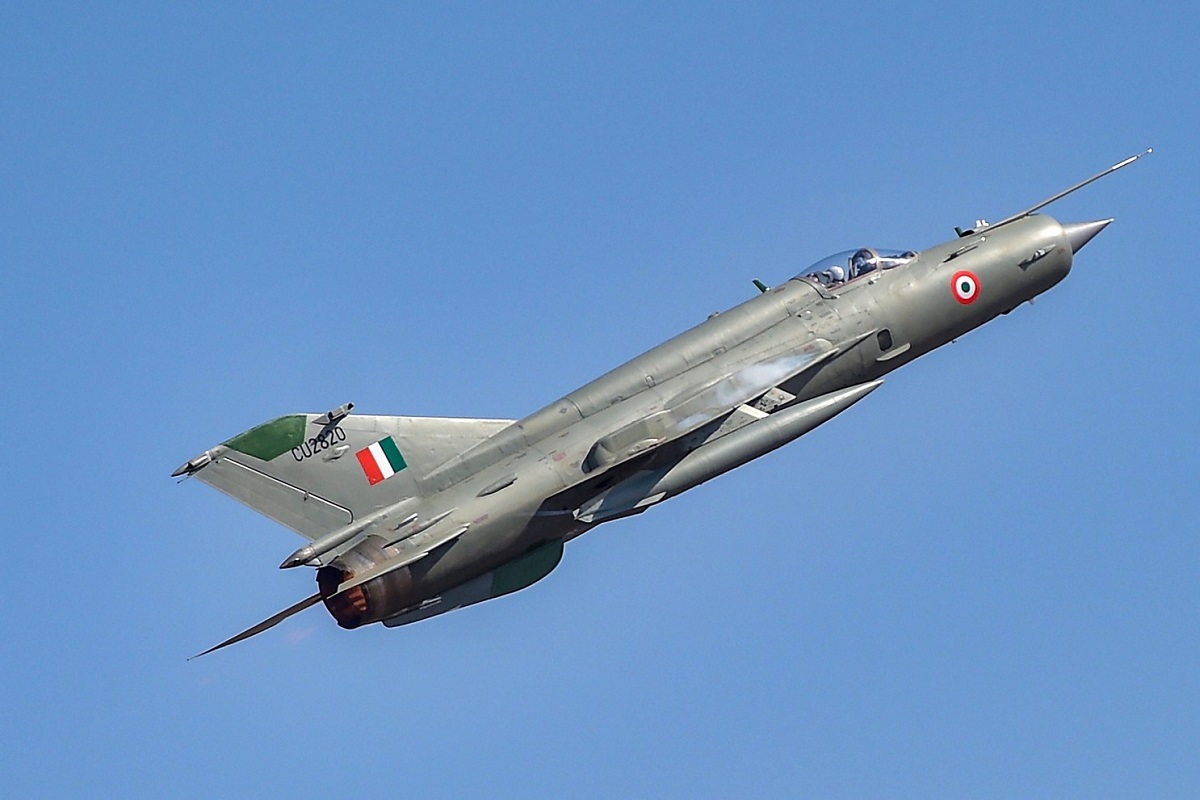Come October 8, and a legend will fly into the sunset. The Soviet-origin MiG-21s would participate in their last flypast in the world on the 91st anniversary celebration of the Indian Air Force (IAF).
MiG-21s have the distinction of being the first supersonic fighter jets of the IAF and one of the force’s longest-serving aircraft. They will be phased out after 60 years of service, and presently, the IAF is the only force in the world flying these vintage jets. The last of the MiG-21 Bis was produced in 1985.
Designed by the Mikoyan-Gurevich Design Bureau (OKB) of the erstwhile Soviet Union, the aircraft undertook its maiden flight on June 16, 1955. The IAF inducted its first single-engine MiG 21 in 1963. At one point, the aircraft were the backbone of the IAF.
After the first MiG-21s arrived, six MiG-21PFs (Type 76) were inducted in 1965. Another 250 MiG-21 FL (Type 77) variant machines were added, and the plane saw another variant called MiG-21M/MFs (Type 96). The most recent variant is MiG-21 Bis (Type 75). The IAF had planned to have a replacement for MiG-21 ready by 1994.
Hindustan Aeronautics Limited (HAL) licence-produced 657 of these jets. Over the years, avionics, missiles, and radars were upgraded with newer versions.
A Legend For Raw Power
The IAF chief Air Chief Marshal V. R. Chaudhari announced this on October 3 at the annual press conference ahead of Air Force Day, “It will be the last flypast of the MiG-21s. The aircraft is planned to be phased out in 2025.”
One squadron of the upgraded MiG-21 ‘Bisons’ will be number-plated in October. And another squadron will follow suit in 2024. Over 100 MiG-21s in the IAF have been upgraded to Bison since 2006.
On the sidelines of the conference, the IAF chief told the EurAsian Times that he would remember the aircraft for its “raw power.” “The aircraft was a pure pleasure to fly. Yes, we faced some issues, but it is a legend that has served us well,” the IAF chief added. The chief has been a MiG-21 pilot himself.
The MiG-21 was a supersonic monster flying faster than twice the speed of sound at Mach 2.25. A vast Tumansky R-11 F-300 engine powered it. It had an R1L radar fitted into its nose cone, which could locate enemy fighters at a range of 20 km.
The MiG-21 FL was armed with two Vympal K-13 (AA-2 Atoll-A) infrared-homing air-to-air missiles. Due to its limited range, the MiG had to carry a drop tank under the fuselage, which could be traded for a GSh-23 twin-barrelled cannon pod.
India got its first single-engine MiG-21 in 1963, and it progressively inducted 874 variants of the Soviet-origin supersonic fighters to bolster its combat potential. The aircraft has seen action in different wars, including the 1971 Bangladesh war, the 1999 Kargil conflict, and the most recent air duel after the Balakot airstrike in 2019.
The Air Chief added: “These MiG-21s will be replaced by indigenous Light Combat Aircraft (LCA) `Tejas’.” The IAF had earlier contracted for 83 LCA-Mk1A, and an additional order for 97 Light Combat Aircraft (LCA) Tejas Mk1A fighter jets is expected later this year.
An American US Air Force’s Constant Peg program pilot has described the ‘Fishbed’ (the NATO name for MiG-21) as a “beefed up, fighter version” of the Northrop T-38 Talon jet trainer. The MiG was fast, simple, and “surprisingly nimble” in simulated dogfights against American pilots in American planes. Although MiG-21s had numerous shortcomings, the Soviets still produced 11,000 of them, prompting McCoy to call the planes “deadly due to sheer numbers.”
When MiG-21 Won 1971 War For India
In December 1971, the IAF had three squadrons of MiG-21s in the east and five squadrons in the west. The fighter jet saw action for the first time on December 4, 1971, marking the beginning of the Bangladesh Liberation War.
Flying Officer Jayendra Sukrut Raj of the Number 4 Oorials shot down a Pakistani Canadair F-86E Sabre over Tezgaon in East Pakistan.

On December 6, Wing Commander Bishnoi led a formation of four MiG-21s from the 28th squadron towards Tezgaon, the only operational PAF Airbase in East Pakistan. Each MiG-21 dropped 500 kg iron bombs directly onto the runway, grounding the Pakistan Air Force (PAF). No PAF Sabre could take off from the cratered runway, and the IAF dominated the skies over East Pakistan within 48 hours.
On the western border, the much-awaited showdown between the Indian MiG-21s and the Pakistani Starfighter occurred on December 12 when Flight Lieutenant Bharat Bhushan Soni shot down a PAF Starfighter over the Arabian Sea.
Meanwhile, the IAF had modified and inducted four MiG-21s into the Tactics and Air Combat Development Establishment. Squadron Leader Tester Jall Master carried out a night bombing of both the Shorkot Road airfield and the Chaklala airbase in West Pakistan. He would later shoot down an F-86 F Sabre on December 9.
During the 1971 war, the MiGs were also employed to attack targets, including a cabinet meeting held by the East Pakistani administration. The fighter jet proved its mettle in the 1971 war.
It saw little action in the 1999 Kargil conflict. In August 1999, the MiG-21 shot down a Pakistani aircraft, Flight Atlantic-91, a French-built Breguet Atlantic plane. All 16 Pakistani personnel, including five officers on board, were killed in the crash.
- Ritu Sharma has been a journalist for over a decade, writing on defense, foreign affairs, and nuclear technology.
- She can be reached at ritu.sharma (at) mail.com